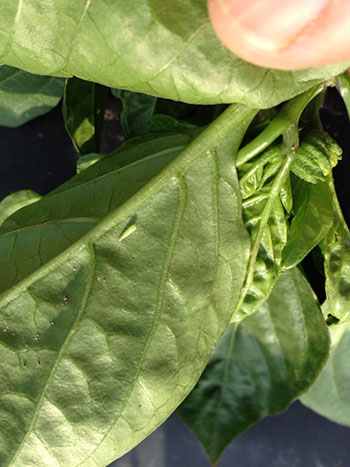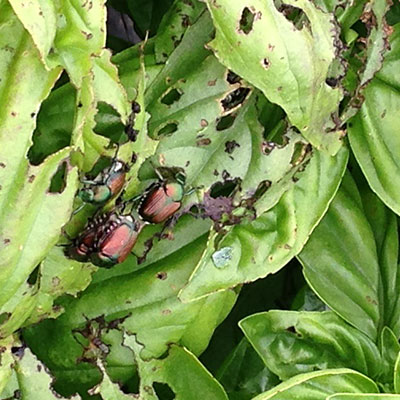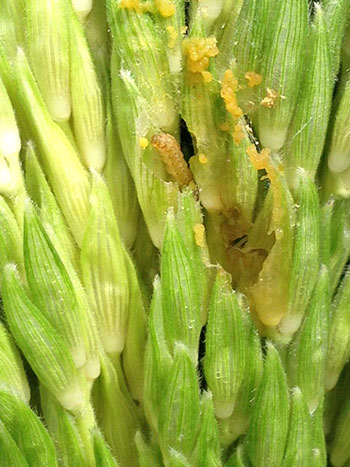Fact Sheet FS1272
Introduction
A variety of pests can be found in hop yards and may lessen yield, reduce quality, or affect plant health. Common insect pests in New Jersey hop yards include leafhoppers, aphids, and Japanese beetles. European corn borer and hop merchant have also been noted as causing some problems. Also, mites (mainly two-spotted spider mites) often cause problems.
Proper identification, timing of control measures, and proper application techniques are key elements to preventing damage to your hop crop. Regular scouting of hop yards in spring and summer is important to know when the pest is present in order to begin using cultural, biological, or chemical controls. Applying insecticidal sprays when insect pests are in low numbers, or when newly hatched, is important to achieve successful control. Following is a detailed description of the common pests found in hops production.
Leafhoppers

Figure 1. Leafhoppers. (Photo: Kris Holmstrom)
The potato leafhopper, Empoasca fabae (Harris), is the most common species in our area that feeds on hops. Leafhopper adults are small, 1/8-inch long, wedge-shaped insects. The potato leafhopper can be distinguished from other leafhoppers by the white spots on the head and thorax. Nymphs (immature stage) are wingless, and are light yellow to light yellowish-green in color. Potato leafhoppers prefer warm, dry conditions and are common in southern states where they overwinter. Due to New Jersey's climate, leafhoppers do not overwinter in our state (Ghidiu 2005). Potato leafhoppers migrate north from southern states and generally arrive in New Jersey during late April or early May.
Females lay 2–4 eggs per day in the leaf stems or veins of hop, with eggs hatching 7 to 10 days later. Afterwards, nymphs undergo five instars and reach full maturity in about two weeks. Newly emerged nymphs are nearly colorless, with red spots that fade as they grow. Nymphs then become yellow, finally changing to pale green in the third and later instars. There are 3–4 generations of potato leafhopper each summer in our region, making them a season-long pest in hops.
Leafhoppers are abundant insects and can multiply rapidly. Since they are strong flyers, they move quickly from plant to plant and are known to serve as vectors for numerous plant diseases.
Populations in nearby host crops will affect populations in hop yards. Therefore, scouting is important to control the pest when first present in nearby fields and in the hop yard to avoid significant damage. Since there are many other host plants for potato leafhopper, populations in nearby crops will affect movement of leafhopper into hop yards. If this insect is not scouted for, damage may be seen before the actual pest is noticed.
The most obvious symptom of potato leafhopper feeding is hopper burn. Hopper burn is the yellowing of the leaf margin that later turns brown. This damage is followed by leaf curling and dry, dead leaves. Hopper burn occurs because potato leafhoppers feed by sucking the juices out of leaf veins and blocking the veins with a toxin found in their saliva. Damage from leafhoppers can reduce yields and overall health of hop yards.
Aphids

Figure 2. Aphids. (Photo: Kris Holmstrom)
There are many different aphids in the region that feed on many different plants. Many aphids may overwinter in New Jersey and thus can be a problem season-long during plant growth. Aphids are found overwintering in forested areas, shrubs and on numerous varied hosts. Aphids in general can be described as small, soft-bodied, slow-moving insects. Colors of aphids range from green, to black, brown, grey, and yellow. Winged and wingless forms can be produced within the same species.
When looking for aphids they are most often found on the underside of leaves or on shoot tips. Aphid adults and nymphs pierce plants with their needlelike mouthparts and extract plant juices from foliage, usually from the undersides of leaves. Plants become weakened and lose vigor, leaves wilt and curl downward, and become distorted and discolored. Heavy damage will cause the leaves to dry up and drop off the plant.
Aphids also secrete honeydew (excrement) that sticks to leaves, shoots, and sometimes cones. The honeydew is a medium on which black sooty mold develops. Sooty mold on cones can make them unmarketable. Another indication of aphids in the yard is when ants are moving up stems into the canopy. Ants also feed on honeydew produced by the aphids.
Lastly, another good reason to control aphids is the fact that they can transmit viruses. Hop mosaic virus and American hop latent virus can be spread via saliva of aphids when moving from plant to plant.
A common aphid that will feed on hops is the Damson hop aphid (Phorodon humuli (Schrank)). The Damson hop aphid is small, 0.05–0.1 inches, pear-shaped, and soft-bodied. It can be either winged or wingless. Those without wings are pale white to green and are typically found on the underside of leaves. The winged version are dark green or brown with black markings on the head and abdomen. Aphids have two cornicles or "tailpipes" at the end of the abdomen that helps with identification of this pest.
Japanese Beetles

Figure 3. Japanese Beetles. (Photo: Kris Holmstrom)
The most common beetle found feeding on hops in New Jersey is the Japanese beetle (Popillia Japonica). The adult Japanese beetle is shiny metallic green with bronze-colored wing covers. Along each side of the abdomen are six tufts of white hair. The adult is about 1/2-inch long. The larva is a large, 1/2- to over 1-inch long grub.
Beetle larvae will overwinter underground, will move upwards in spring when soil temperatures warm, then begin feeding on roots, only to later emerge as flying adults that will feed on leaves and shoots. Adult beetles begin feeding in late May and can continue feeding into summer.
The beetles can cause significant damage to hop foliage and bines in a very short period of time if left uncontrolled. Just two beetles can strip a large hop leaf in a single day. When their numbers multiply and are left uncontrolled, beetles can strip a hop yard in just a few days (Mahafee, et.al. 2009). Beetles have two generations during the growing season, with feeding occurring throughout most of the production season.
Controlling beetles in the hop yard can pose a challenge. Adult beetles will cause damage by feeding on foliage and large numbers can fly in from different areas. Hop yards that are near wooded areas or near other favored host crops may be an attractive area for beetles to move into once other feeding sources are dried up or depleted. Regular insecticide applications are warranted once feeding begins.
European Corn Borer
The European corn borer, Ostrinia nubilalis (Hübner), is a serious pest to over 200 different host plants, especially vegetable and field crops. However, they have been known to deposit eggs on hops, and larvae can feed on shoots and tunnel into bines, causing significant damage.
The adult moths are not easy to find since they fly mainly at night. Female moths have a 1-inch wingspread and are a pale yellowish-brown with irregular dark wavy lines across their wings. Males are slightly smaller and are darker in color with olive-brown marks on their wings. Adults can be monitored using black light traps that can predict when populations are high, indicating larvae may be found in nearby host crops.

Figure 4. European Corn Borer Larvae. (Photo: Kris Holmstrom)
The Rutgers New Jersey Agricultural Experiment Station (NJAES) maintains a network of black light traps throughout the state to assist growers with monitoring; see plant-pest-advisory.rutgers.edu/?s=corn+borer. Females lay flattened, light-gray eggs in overlapping, scale-like masses of 20–30 eggs, forming a mass about 1/4 inch across and covered with a shiny waxy substance. Once hatched, eggs produce young larvae that are whitish with a black head and several rows of small round black or brown spots along the body. Mature larvae are about 1 inch long and have pinkish to flesh-colored bodies.
In New Jersey, mature larvae can overwinter by tunneling into stubble, stalks, or stems of the host plants, including many weeds. Then in April and May, larvae will pupate and moths appear in mid-May to June. If warm temperatures occur and humidity is high, females deposit eggs that hatch in 3 to 10 days. Young larvae begin feeding, once hatched on cones, leaf axils and will bore into vines. In early July the next pupation occurs, and in a couple of weeks the second generation of moths can be found in New Jersey. In the northern areas of the state, this second generation of moths lay eggs and larvae that will find hosts to use for overwintering. In southern New Jersey, a few second generation larvae will transform into pupae and adults, giving rise to a partial third generation that will not survive the winter (Ghidiu 2006).
European corn borer adults are difficult to control due to nighttime fight patterns. Therefore, controlling larvae is the best option. When eggs are first hatched, larvae are most susceptible to insecticides. When scouting hops look at cones, leaf axils, and undersides of leaves for larvae and feeding. Holes and stems with frass (excrement) deposits near the entrance are also indicators of larvae that have tunneled into vines. Once inside the plant, control will be difficult.
Hop Merchant
Hop merchant is a relatively small, inconspicuous butterfly that is rather closely associated with moist woods, but it sometimes strays into other areas. The hop merchant is also referred to as the eastern comma (Polygonia comma). Hop merchant is generally perceived as a pest with no economic importance. However, this might be because the Pacific Northwest, where most of the hops industry is located, is outside of the hop merchant's habitat range. There have been reports throughout the east coast of hop merchant larvae feeding on hops.
Full-grown larvae are approximately 1.2 inches in length. The head has short spines and a pair of branching spines on top. Body color is highly variable, from white to greenish-brown to black, and the branching spines (scoli) on the body are also variable from black to white with black tips (Hall 2015).
Mites
Mites are not insects, but are eight-legged and are considered arachnids, like ticks and spiders. Mites can cause damage to hop plants by piercing leaf tissue, feeding on plant sap. Leaf feeding will cause silvering or bronzing discoloration on foliage. Damage on cones can cause significant crop loss and will show up as dry, brittle, and discolored (red) cones that may shatter from the bine. The two-spotted spider mite (Tetranychus urticae (Koch)) is the most common mite on hop. Females are larger than males, at 0.04–0.06 cm long, with males being about three-fourths the size of females (Mahafee, et. al. 2009). They are yellowish in color with a large dark spot on each side of the abdomen for both sexes.
Females can lay up to 16 eggs in a single day with up to 240 eggs over their lifetime, making this pest extremely prolific. When environmental conditions are favorable, mite populations can increase rapidly. Optimum temperatures for mite egg hatching and larval development are around 82°F.
Mites thrive under dry environmental conditions and may be washed off from leaves during heavy rainfall events. Mites also favor stressed and dust-covered plants. Therefore, preventing drought stress and properly fertilizing hop yards is important. Additionally, planting a low-growing turf or other non-competing cover crop will reduce dust and also create an environment for beneficial insects. When selecting a pesticide, be sure to choose a miticide; many insecticides will not control mites.
Insect Management and Control
Insect management in hop yards can be difficult since bines grow very high up, onto training strings. When shoots are first emerged and when at eye level, scouting for insect pests is easier. Checking new growth tips, undersides of leaves for live insects and generally looking for feeding signs are all important when scouting for insect pests. Applying insecticide controls should be administered after the pest has been properly identified, when numbers warrant application, before pest populations become too high, and are generally most effective when pests are newly hatched. Be sure to read the pesticide label and follow all instructions before making an application. All pests mentioned above are predominantly flying insects. Flying insects travel to the host plants from other areas and once established in a region, will most likely be a problem throughout the season.
Sanitation of the hop yard is one cultural control method that is extremely important for the future health of the crop. Any leftover refuse from harvest and uncut bines should be removed from the area after the first hard freeze since they may still contain live insects. Waiting until after the first hard freeze may reduce levels of pests on the debris and when moving debris out of the field. However, movement of infected material may spread pests to unaffected areas of the yard.
The waste collected can be burned to eliminate infested debris. Be sure to obtain a NJDEP Forest Fire Service open burning permit. Burning permits for infested plant life are required and need to be signed by your county agricultural agent certifying the reason for burning is due to disease infection. They are then sent to the Forest Fire Service in your region for approval. The forms are available from your local agricultural agent at your Rutgers NJAES Cooperative Extension county office. See njaes.rutgers.edu/county for the location in your county.
Pesticide Recommendations
New Jersey does not currently have pesticide recommendations for insect control in hop yards. When using recommendations from other states, first confirm if the pesticide is approved for use in New Jersey with the Department of Environmental Protection. Please read the pesticide label for all instructions, regulations, and uses. Information available for pest control products can be found via the following sources:
- Gent, D.H., Barbour, J.D., Dreves, A.J., James, D.G., Parker, R., and Walsh, D.B. 2009. Field Guide for Integrated Pest Management in Hops. Oregon State University.
- University of Idaho, U.S. Department of Agriculture - Agricultural Research Service, and Washington State University ipm.wsu.edu/field/pdf/hophandbook2009.pdf (PDF).
- Darby, H. and L. Calderwood. 2015 Hop Pest Scouting Report. University of Vermont. www.uvm.edu/extension/cropsoil/wp-content/uploads/2015HopPestScoutingFINAL.pdf (PDF).
References
April 2017
Copyright © 2024 Rutgers, The State University of New Jersey. All rights reserved.
For more information: njaes.rutgers.edu.
Cooperating Agencies: Rutgers, The State University of New Jersey, U.S. Department of Agriculture, and Boards of County Commissioners. Rutgers Cooperative Extension, a unit of the Rutgers New Jersey Agricultural Experiment Station, is an equal opportunity program provider and employer.

